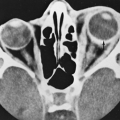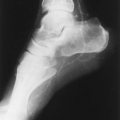DEFINITION
Part of “CHAPTER 43 – ENDOCRINE OPHTHALMOPATHY“
Endocrine ophthalmopathy is a complex orbital disease of unknown cause characterized by round-cell infiltration, edema, and proliferation of connective tissue. These changes affect predominantly the extraocular muscles and to a lesser degree the lacrimal glands and retrobulbar fat. Usually, exophthalmos, or protrusion of the eyeballs, is present. Endocrine ophthalmopathy may occur alone, in association with diffuse thyrotoxic goiter or pretibial myxedema, or with both conditions. These findings form part of the symptom complex that is termed Graves disease (see Chap. 42).
Endocrine ophthalmopathy, or endocrine exophthalmos, the latter term coined by Brain1 in 1959, is a useful but somewhat misleading appellation because the orbital changes may occur without endocrine abnormalities. McKenzie2 defined the association of ophthalmopathy with endocrinopathy as a “multisystem disorder of unknown etiology, characterized by one or more of three clinical entities: (a) hyperthyroidism associated with diffuse hyperplasia of the thyroid gland, (b) infiltrative ophthalmopathy, and (c) infiltrative dermopathy (localized pretibial myxedema).” The condition is more common in women, but often the most severe cases are encountered in men. The genetics of ophthalmopathy appear to be linked to those of Graves disease, with severity of disease distinguished by certain human leukocyte antigen (HLA) types.3 Reported estimates of the prevalence of ophthalmopathy in Graves disease vary widely from 4% to 60%, probably owing to variation in both definition and the sensitivity of detection techniques. Excluding eyelid signs, only 5% to 20% of Graves patients have ophthalmopathy, but the rate rises to 60% or more when computed tomography (CT) or magnetic resonance imaging (MRI) techniques are used to uncover otherwise unapparent muscle involvement.
Stay updated, free articles. Join our Telegram channel

Full access? Get Clinical Tree








